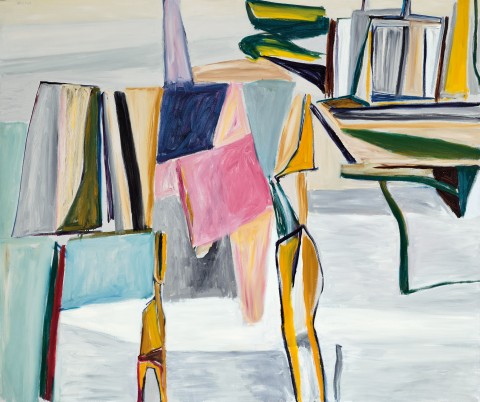FLAG FOR DAVID IRELAND, NO. 1, FOR THE UNKNOWN INDUSTRIAL PRISONER, 1979
KEN WHISSON
oil on canvas
100.0 x 119.0 cm
signed upper left: WHISSON
inscribed with title on stretcher bar verso: FLAG FOR DAVID IRELAND No 1 FOR THE UNKNOWN INDUSTRIAL PRISONER
Niagara Galleries, Melbourne
Private collection, Sydney, acquired from the above on 29 June 1988
Flag for David Ireland No. 2, 1979 – 80, oil on canvas, 89 x 119 cm, in the collection of the Heide Museum of Modern Art, Victoria
This masterful work by Ken Whisson takes its title from David Ireland’s 1971 novel, The Unknown Industrial Prisoner, a dark comedy about a post WWII industrial dystopia set in an oil refinery in Sydney. The characters in the book are known only by odd nicknames such as ‘The Samurai’, ‘The Good Shepard’, ‘The Glass Canoe’, or the local madam known as ‘The Old Lamp Lighter’. These names heighten the calamitous nature of the book, each offering insights into physical or attitudinal aspects of the characters.
Whisson’s paintings often meld figures into interiors or landscapes; thus when considered within the context of the artist’s leftist politics, the idea of Ireland’s refinery workers painted against the industrial backdrop afforded perfect material for Whisson. The book’s fractured narrative creates a sense of space akin to cubism, which also aligns well with Whisson’s working methods. The narrative is written as a series of short, fragmented episodes, and there is no real plot, but rather an unravelling sequence of events. Similarly, Whisson’s paintings are spatial with no linear narrative in the sense that each work finishes, where it ends up and vice versa.
The current work belongs to a series considered very important in Whisson’s career. Known amongst collectors and critics as his ‘Flag paintings’, they were painted in Italy in the late 1970s and represent an important transition between works created before his move to Italy and everything that followed. Typically, Whisson’s flag paintings lean towards total abstraction – their pockets of bright forms interspersed with areas of white paint create an open fractured surface, which was to become a lasting feature of Whisson’s work. Each painting in the series has a title such as Flag for a Small Lethal Army, Flag off My Disposition, or in this case, Flag for David Ireland, No 1. The word flag provides each work with a political charge, albeit of personal significance to the artist. As former MCA curator Glen Barkley wrote, ‘…Flag for The Red Brigades and the Hudson Institute, 1978, brings together the unthinkable… the Hudson Institute with its atomic annihilation scenarios… and the Red Brigade terrorist group, who had made the unthinkable a reality by pursuing a violent political trajectory that culminated in the kidnapping and murder of the Italian prime minister Aldo Moro in 1978.’1 Recognisable forms that existed in his work until now, become interwoven through shape, colour and line into the overall compositions. In pictorial terms, this worked well for Whisson and his depiction of Ireland’s industrial dystopia where workers are regarded simply as extensions of the refinery in the eyes of the company and as such, morph into the industrial landscape. Significantly Ireland’s title ‘The Unknown Industrial Prisoner’ – while clearly describing the anonymity of the workers in the plant – is also the name of a welded steel, abstract sculpture typical of the time. It was created by a manager at the plant and was said to be ‘…symbolic of the intense pressures on modern industrial man and the sense of compression and isolation in a confined space.’2
By the time Whisson had painted this work, he had settled permanently in Italy and into the rhythm of painting, and was regularly sending the paintings back to Australia for annual exhibitions, either with Ray Hughes in Brisbane, or the Watters Gallery in Sydney. Over a lifetime, Whisson quietly cemented his place in the canon of Australian painting. And until his sudden death at 94 in February this year, was painting daily with as much vigour and passion as he ever had. The consistency of his output over many decades is unmatched and his often-polarising paintings are simply unique in Australian art. His 2012 retrospective exhibition held at Sydney’s Museum of Contemporary Art and the Heide Museum of Modern Art in Victoria, was a brilliant and up lifting testimony to his importance. Whisson was a painter dedicated to an art that is not simply fashionable, but deeply rooted in ideas and painterly possibilities.
1. Barkley, G., and Harding, L., Ken Whisson. As If, Heide Museum of Modern Art, Melbourne and Museum of Contemporary Art, Sydney, 2012, p. 23
2. Ireland, D., The Unknown Industrial Prisoner, Text Publishing, Melbourne, 1971, p. 394
HENRY MULHOLLAND
